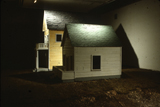From the Outskirts to the Center
| Rita Mckeough has led a rather nomadic existance. Having lived all over Canada, she moved frequently, and has made art and taught in most provinces. Her commitment to students is well known, as is her ability to make them think about things they haven’t considered. In early 2003, I attended one of her workshops at the Artist-run center Struts, in Sackville, New Brunswick.I had never met her, and didn’t know her work very well. The workshop began in an orderly fashion – people had clear plans and we recorded coherent tapes of voice work and dialogue. It was interesting, there was poetry, reading, organized structure. I anticipated that we would tape of each of our audio compositions separately. We were then led into layering our sound work underneath all kinds of other technology, video projections, lighting, other sound, movement and performance. It was mayhem, and I saw the original ideas slide and slither away in a cacaphonic sea.
The lighting in the room was irregular, jagged and discordant. Loud percussive music of sorts was occurring, or it might have been feedback. The other people were engaged, all doing bizarre things, it was hard to tell what. The technology malfunctioned and then worked again. A camera was sweeping the space, and lights kept changing. It felt supremely silly. At one point I found myself braying like a donkey- a primitive gutteral inhaling sound – and using a broom to sweep the ceiling. Where this came from I had no idea, as I am usually quite circumspect in public. I was laughing uncontrollably and couldn’t stop. I still had barely said hello to Rita Mckeough. A number of months later I met that woman, she was sitting quietly, carving bars of Ivory soap, chatting and visiting while making her work. In retrospect the occasions revealed much about McKeough and her practice. I was permitted a glimpse into the chaotic complexity and humour of her environments, and participated in the enactment of release that she enables. Through her work and her fearlessness, she brings us towards a dissolution of internal and social barriers. Her work is profoundly honest, it takes on the big themes of our times, it arises out of a sense of engaged protest, it is fundamentally political. For McKeough, teaching is a means of staying connected to a community, sustaining links that she values immensely. She stays in contact with many students well after they graduate, taking a keen interest in their work. I met some of her former students – Graham Patterson and Peter Flemming . They had been hired by Rita as technical assistants for “Outskirts”. Both are extraordinary artists in their own right; making elaborate mind- boggling animated videos (G. Patterson) and nationally recognized kinetic sculptural installations ( P. Flemming ). McKeough’s reputation as a renegade flourished decisively during an undergraduate year at the Kootenay School of Art in British Columbia. She spearheaded a couple of “incidents”. With friends, she attached wheels to the drawing donkeys and raced them through the carefully monitered hallways of the institution; she helped publish scathing criticisms of the college in the student newspaper. After she barricaded herself into a room, in protest against the poor conditions at the school – she learned that she was no longer welcome as a student. Mckeough had finally stepped outside the dusty mores of the college. After completing her BFA at the University of Calgary, Rita Mckeough made her first, and radical installation. The whole floor of the Dandelion gallery was flooded with 4 inches of water, and debris floated around in the space. Her work since those days has been marked with a sense of idealism and social activism. Subversive humour has also been present since the beginning, along with a kind of carnivalesque joyousness. Perhaps her most elaborate performance was Tower of Silence at the St Norbert Art Center near Winnepeg, Manitoba. The site has a special history where the ruins of an old monastery settle into a lovely park. Trappist monks used to live there under a code of silence, spending their days in meditation and prayer. McKeough built a gigantic structure that leaned against a ruined church wall. It was in the shape of an “H” – a silent consonent in our alphabet, silent in many languages when spoken. The “H” was 40’ tall, and a group of women performers scaled the giant structure, engaging in work and ritual until they finally succeeded in hauling ladders up the front wall of church. Different kinds of silence, imposed, cultural, spiritual, institutional – silence as a balm, as prayer, and silence of exclusion are all conjured up in this piece. At the same time, there was garden full of laughing roses, the roses were wired to laugh outright. McKeough speaks of future projects in terms that suggest a mind always at work, an encompasssing vision at once elaborate and playful. A forest on parade, buildings that harbour sounds in their very building materials. Not simply the idea of inanimate elements somehow listening in and absorbing human dramas, but through imagination and diffuse general empathy, Rita McKeough listens, and imagines sounds that conveys the subjectivities of muted forms. McKough constructs environments where she taps into a various energies, human, electric, electronic, animal. It is a world that reveals reason gone awry, a part- mechanized and artificial natural environment. The artist embodies subversive strategies that reveal how much damage has been done. Louise May |
 |
